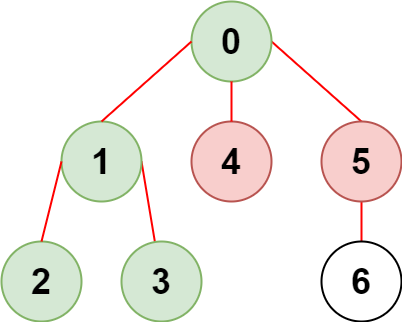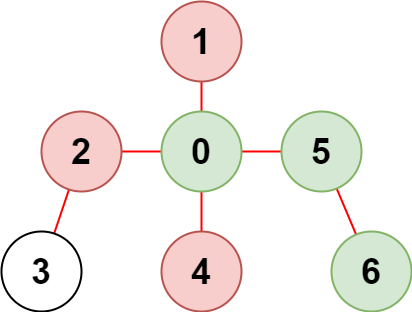Welcome to Subscribe On Youtube
2368. Reachable Nodes With Restrictions
Description
There is an undirected tree with n nodes labeled from 0 to n - 1 and n - 1 edges.
You are given a 2D integer array edges of length n - 1 where edges[i] = [ai, bi] indicates that there is an edge between nodes ai and bi in the tree. You are also given an integer array restricted which represents restricted nodes.
Return the maximum number of nodes you can reach from node 0 without visiting a restricted node.
Note that node 0 will not be a restricted node.
Example 1:

Input: n = 7, edges = [[0,1],[1,2],[3,1],[4,0],[0,5],[5,6]], restricted = [4,5] Output: 4 Explanation: The diagram above shows the tree. We have that [0,1,2,3] are the only nodes that can be reached from node 0 without visiting a restricted node.
Example 2:

Input: n = 7, edges = [[0,1],[0,2],[0,5],[0,4],[3,2],[6,5]], restricted = [4,2,1] Output: 3 Explanation: The diagram above shows the tree. We have that [0,5,6] are the only nodes that can be reached from node 0 without visiting a restricted node.
Constraints:
2 <= n <= 105edges.length == n - 1edges[i].length == 20 <= ai, bi < nai != biedgesrepresents a valid tree.1 <= restricted.length < n1 <= restricted[i] < n- All the values of
restrictedare unique.
Solutions
-
class Solution { private List<Integer>[] g; private boolean[] vis; private int ans; public int reachableNodes(int n, int[][] edges, int[] restricted) { g = new List[n]; Arrays.setAll(g, k -> new ArrayList<>()); vis = new boolean[n]; for (int v : restricted) { vis[v] = true; } for (int[] e : edges) { int a = e[0], b = e[1]; g[a].add(b); g[b].add(a); } ans = 0; dfs(0); return ans; } private void dfs(int u) { if (vis[u]) { return; } ++ans; vis[u] = true; for (int v : g[u]) { dfs(v); } } } -
class Solution { public: int ans; int reachableNodes(int n, vector<vector<int>>& edges, vector<int>& restricted) { vector<vector<int>> g(n); for (auto& e : edges) { int a = e[0], b = e[1]; g[a].push_back(b); g[b].push_back(a); } vector<bool> vis(n); for (int v : restricted) vis[v] = true; ans = 0; dfs(0, g, vis); return ans; } void dfs(int u, vector<vector<int>>& g, vector<bool>& vis) { if (vis[u]) return; vis[u] = true; ++ans; for (int v : g[u]) dfs(v, g, vis); } }; -
class Solution: def reachableNodes( self, n: int, edges: List[List[int]], restricted: List[int] ) -> int: g = defaultdict(list) vis = [False] * n for v in restricted: vis[v] = True for a, b in edges: g[a].append(b) g[b].append(a) def dfs(u): nonlocal ans if vis[u]: return ans += 1 vis[u] = True for v in g[u]: dfs(v) ans = 0 dfs(0) return ans -
func reachableNodes(n int, edges [][]int, restricted []int) int { g := make([][]int, n) for _, e := range edges { a, b := e[0], e[1] g[a] = append(g[a], b) g[b] = append(g[b], a) } vis := make([]bool, n) for _, v := range restricted { vis[v] = true } ans := 0 var dfs func(u int) dfs = func(u int) { if vis[u] { return } vis[u] = true ans++ for _, v := range g[u] { dfs(v) } } dfs(0) return ans } -
function reachableNodes(n: number, edges: number[][], restricted: number[]): number { let res = 0; const vis = new Array(n).fill(false); const map = new Map<number, number[]>(); for (const [start, end] of edges) { map.set(start, [...(map.get(start) ?? []), end]); map.set(end, [...(map.get(end) ?? []), start]); } const dfs = (cur: number) => { if (restricted.includes(cur) || vis[cur]) { return; } res++; vis[cur] = true; for (const item of map.get(cur) ?? []) { dfs(item); } }; dfs(0); return res; }